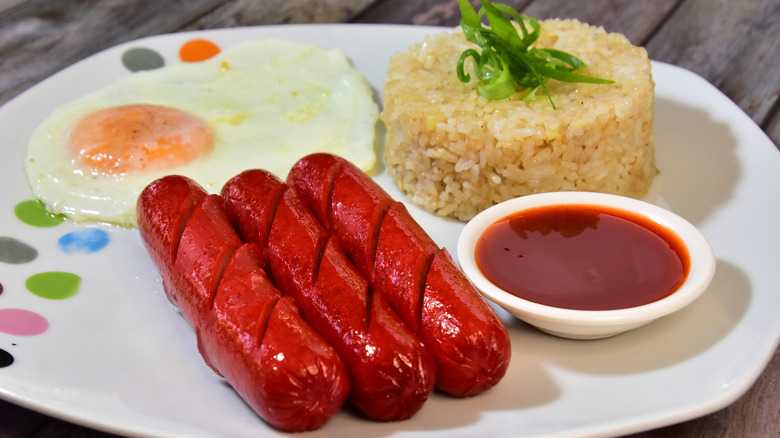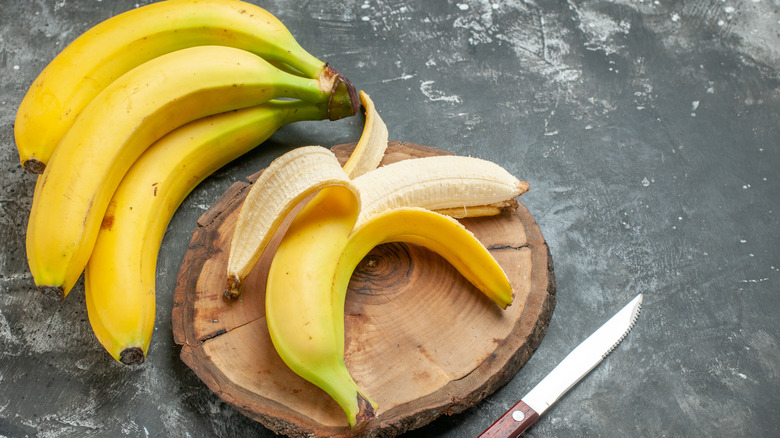What Makes Filipino Hot Dogs So Unique?
The hot dog is, to use a food-related aphorism, as American as apple pie. At cookouts and ball games, there is no treat as welcomed as a juicy frank served hot and fresh in a soft bun with your choice of toppings. Purists will quibble on the specifics of the best hot dogs: Is a Chicago-style dog with pickle and celery salt (and absolutely without ketchup) the definitive weenie? How about the Coney hot dog, with its loving application of chili under a swath of mustard and crisp, pungent diced onion? There's no universal consensus.
Enter, a unique and unexpected contender: the Filipino hot dog. Over 4,000,000 people of Filipino descent live in America and, among the delicacies they've woven into the fabric of our melting pot culture, is their spin on the hot dog. According to Richard Pink, co-owner of the famous Pink's Hot Dogs, in an interview with the Asia Society, "Filipinos like American products ... Certainly, the hot dog is an iconic American food."
A Filipino hot dog is fried or grilled and topped with the tasty accoutrements that make it so unique. Sometimes, it isn't even served in a bun but beside rice and a fried egg instead. Garlic oil and a pickled papaya condiment called atchara are typical accompaniments, but the real star of the Filipino hot dog is its special sauce: banana ketchup.
The secret is in the sauce
The concept of banana ketchup could leave some Americans scratching their heads ... until they try it and realize what they've been missing. Banana is the star of banana ketchup, obviously, along with the sugar, vinegar, and seasoning that you'd find in tomato ketchup. While tomato ketchup is known to be tart and have a distinctive acidic kick, banana ketchup has a more mellow, fruity sweetness that's really appealing.
Banana ketchup has a higher sugar content than its tomato-centric cousin, which could be a red flag for those trying to cut back. Overall, though, bananas are packed with health benefits that you wouldn't expect. The taste is not an exact swap for tomato ketchup, but few people use it as a 1-to-1 substitute. Rather, banana ketchup earns its place of pride at the table as its own entity, something that can be used for dipping, flavoring meat dishes, or kicking up rice-based meals. On Filipino hot dogs, banana ketchup brings a unique sweetness that perfectly complements the tropical flair of the papaya in the atchara and lends a distinct flavor profile to the dog.
Filipino hot dogs have a humble backstory
Many elements of the one-of-a-kind Filipino hot dog, including the banana ketchup, come from creativity driven by hard times. During World War II, tomatoes were in short supply in the Philippines. What the Filipinos had in abundance, however, were bananas. The prevalence of this fruit inspired its substitution in the traditional ketchup preparation, and the rest was history.
Likewise, Filipino hot dogs — the actual meat product — were an invention derived from scarcity as well. While beef, typical of an American frank, was less common, pork blends stepped up to the plate. Hot dogs in the Philippines also have a distinctive bright red color that is achieved with food dye. The other elements that make the Filipino hot dog a culinary tour de force similarly borrow from common cultural elements that were cheap and plentiful, like papaya and garlic. The best foods from around the world are often derived from what is on hand, and Filipino hot dogs are no different.


